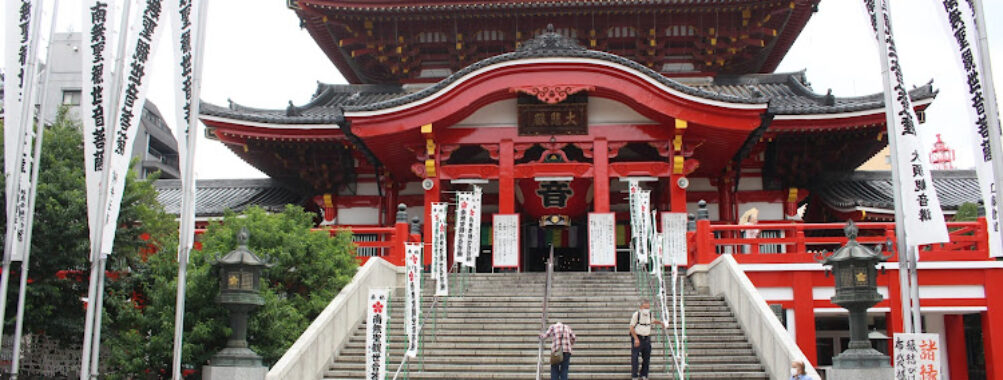
Osu Kannon (Kitanosan Shinpuku-ji Hoshoin)
Table of Contents
Description
Osu Kannon, officially known as Kitanosan Shinpuku-ji Hoshoin, is a Buddhist temple with a story that stretches back to the 14th century. Although it’s been rebuilt over the centuries, this place still carries that old-world charm that feels like stepping into a quiet corner of history. What really caught my attention (and I’m guessing it’ll grab yours too) is its impressive library housing classical works—seriously, a treasure trove for anyone even remotely curious about Buddhist texts or Japanese history. It’s not just a temple; it’s a living archive.
Now, I gotta say, the vibe here is a bit different from some other temples you might have visited. You’ll find the usual temple pigeons hanging around, adding a bit of life (and, well, a little mess) to the otherwise serene atmosphere. If you’re someone who enjoys a bit of nature mingled with culture, those birds kind of grow on you after a while. But heads up—this place isn’t exactly the easiest for everyone to access. Wheelchair users might find it tricky since there’s no wheelchair accessible entrance or parking. So, if mobility is a concern, plan accordingly.
One thing I noticed during my visit was how the temple manages to balance being a popular tourist destination while still holding onto a sense of calm and reverence. It’s not overrun with crowds, but there’s enough foot traffic to feel safe and lively. The restrooms are clean and well-maintained, which is a small thing but honestly, when you’re out exploring, finding a decent restroom can be a lifesaver.
What’s really cool is that Osu Kannon offers onsite services, so if you’re up for a more immersive experience, you can actually participate in some of the temple’s rituals or events. It’s not just a photo-op spot; it’s a place where you can connect with the spiritual side of Japanese culture in a genuine way.
Key Features
- Founded in the 14th century with a rich historical background
- Rebuilt temple architecture blending traditional and restored elements
- Extensive library of classical Buddhist works—perfect for history buffs
- Onsite religious services providing authentic cultural experiences
- Presence of local pigeons adding a rustic, lived-in feel to the grounds
- Clean restroom facilities available on site
- Moderate visitor traffic ensuring a peaceful atmosphere without feeling deserted
- Located in a lively district, making it easy to combine with other sightseeing
Best Time to Visit
Honestly, Osu Kannon doesn’t have a crazy seasonal rush like some other temples, which is a blessing if you hate fighting crowds. Spring and autumn are probably the best bets if you want to catch some mild weather and maybe see a touch of nature’s color show around the temple grounds. The cherry blossoms in spring can be quite a sight, though the temple itself isn’t exactly a blossom hotspot, so don’t expect a sakura explosion.
Winter visits are quieter and can feel a bit more contemplative, but it can get chilly, so bundle up. Summer? Well, it’s hot and humid, as you’d expect in Japan, so if you’re not a fan of sweating buckets while wandering temple grounds, maybe think twice. Early mornings or late afternoons are great for avoiding the midday sun and getting some lovely soft light for photos.
How to Get There
Getting to Osu Kannon is pretty straightforward, especially if you’re already exploring the city. It’s well connected by public transportation, with a couple of train and subway stations within walking distance. If you’re the kind of traveler who likes to wander on foot, the surrounding neighborhood is a lively area with shops and eateries, so you can easily turn your trip into a half-day adventure.
Taxi rides are an option but can be pricier, especially during peak hours. Parking is limited and not wheelchair accessible, so driving isn’t the most convenient choice unless you’re prepared to walk a bit. For those using public transit, the temple is best reached via the city’s subway lines, and once you’re nearby, just follow the signs or ask a friendly local—they’re usually happy to point you in the right direction.
Tips for Visiting
First off, wear comfortable shoes. The temple grounds are mostly flat but you’ll want to explore the surrounding streets too, and trust me, your feet will thank you. Also, bring some cash. While many places in Japan are moving toward cashless payments, smaller vendors around the temple and donation boxes are still cash-only.
If you’re into photography, try to visit early in the day. The morning light plays beautifully on the temple’s architecture, and you’ll avoid most of the other tourists. But don’t be that person who’s glued to their camera the entire time—take a moment to just soak it all in. There’s something about the quiet hum of temple life, the flutter of pigeons, and the scent of incense that photos just can’t capture.
Speaking of incense, if you want to join in on the spiritual side, don’t hesitate to participate in the offerings or rituals. It’s a respectful way to engage and can make your visit feel more personal. Just watch what the locals do and follow their lead.
Lastly, keep in mind that while the temple is a cultural gem, it’s also a place of worship. So, try to keep noise to a minimum, avoid flash photography inside sacred areas, and be mindful of the people who come here for prayer and reflection.
Visiting Osu Kannon is like stepping into a quiet storybook where history, culture, and everyday life blend in a way that feels both timeless and alive. If you’re planning a trip, don’t just tick it off your list—give yourself the time to really feel the place. You might just find it’s one of those spots that sticks with you long after you’ve left.
Location
Places to Stay Near Osu Kannon (Kitanosan Shinpuku-ji Hoshoin)
Find and Book a Tour
Explore More Travel Guides
No reviews found! Be the first to review!